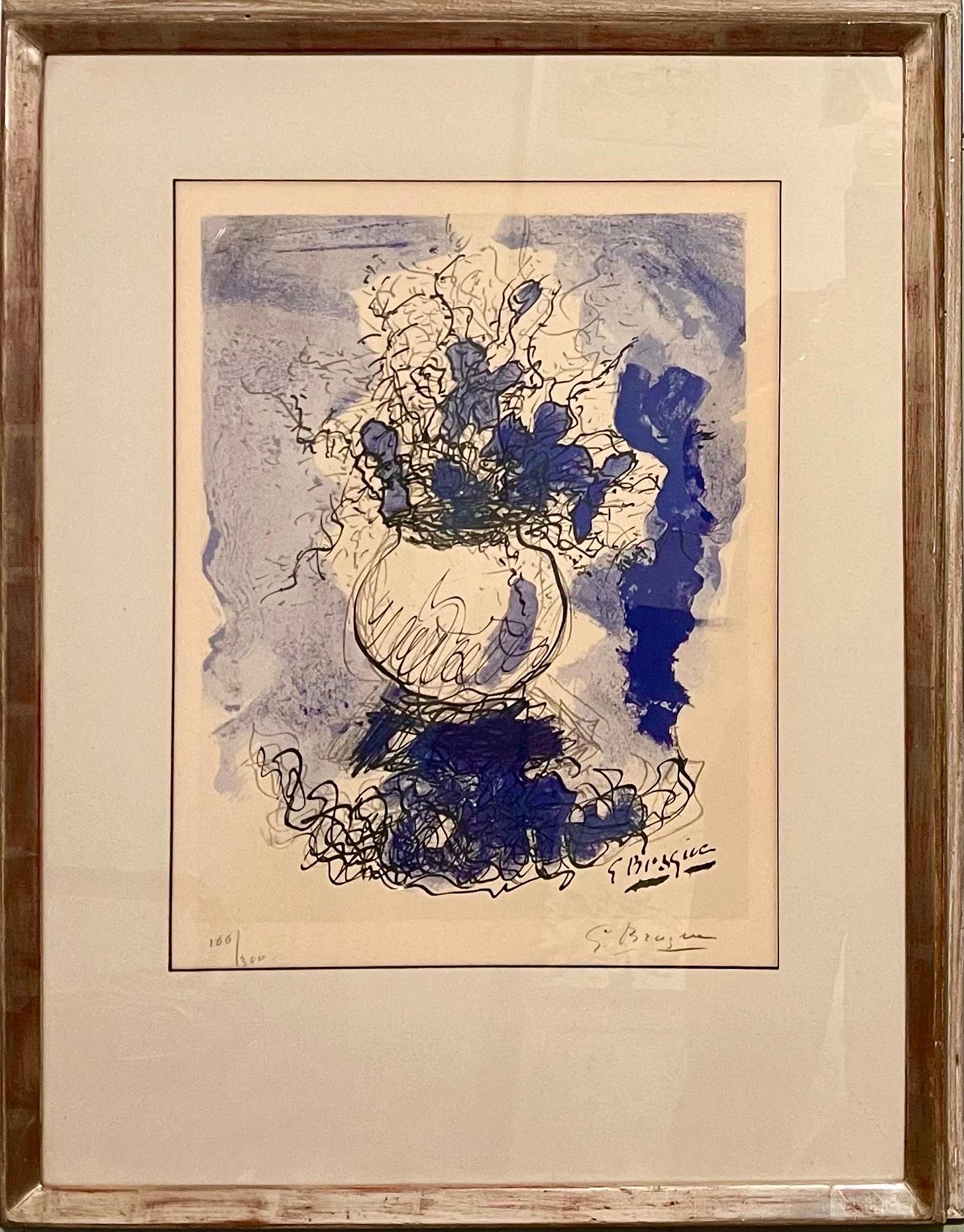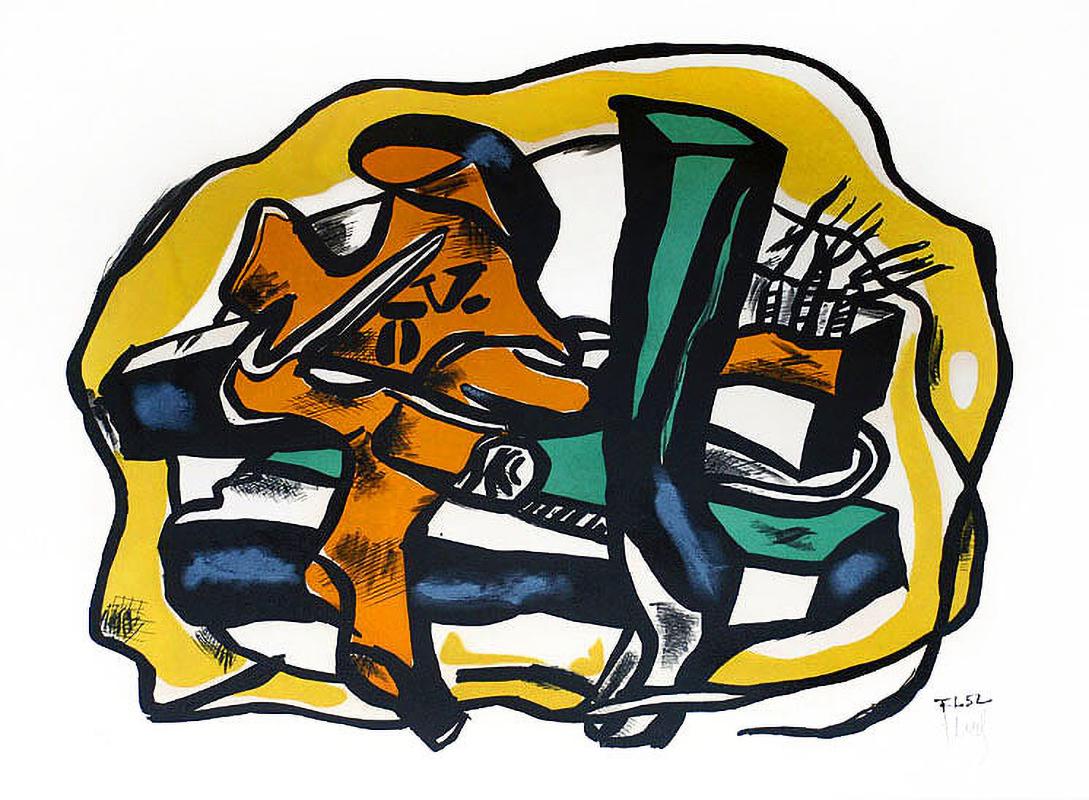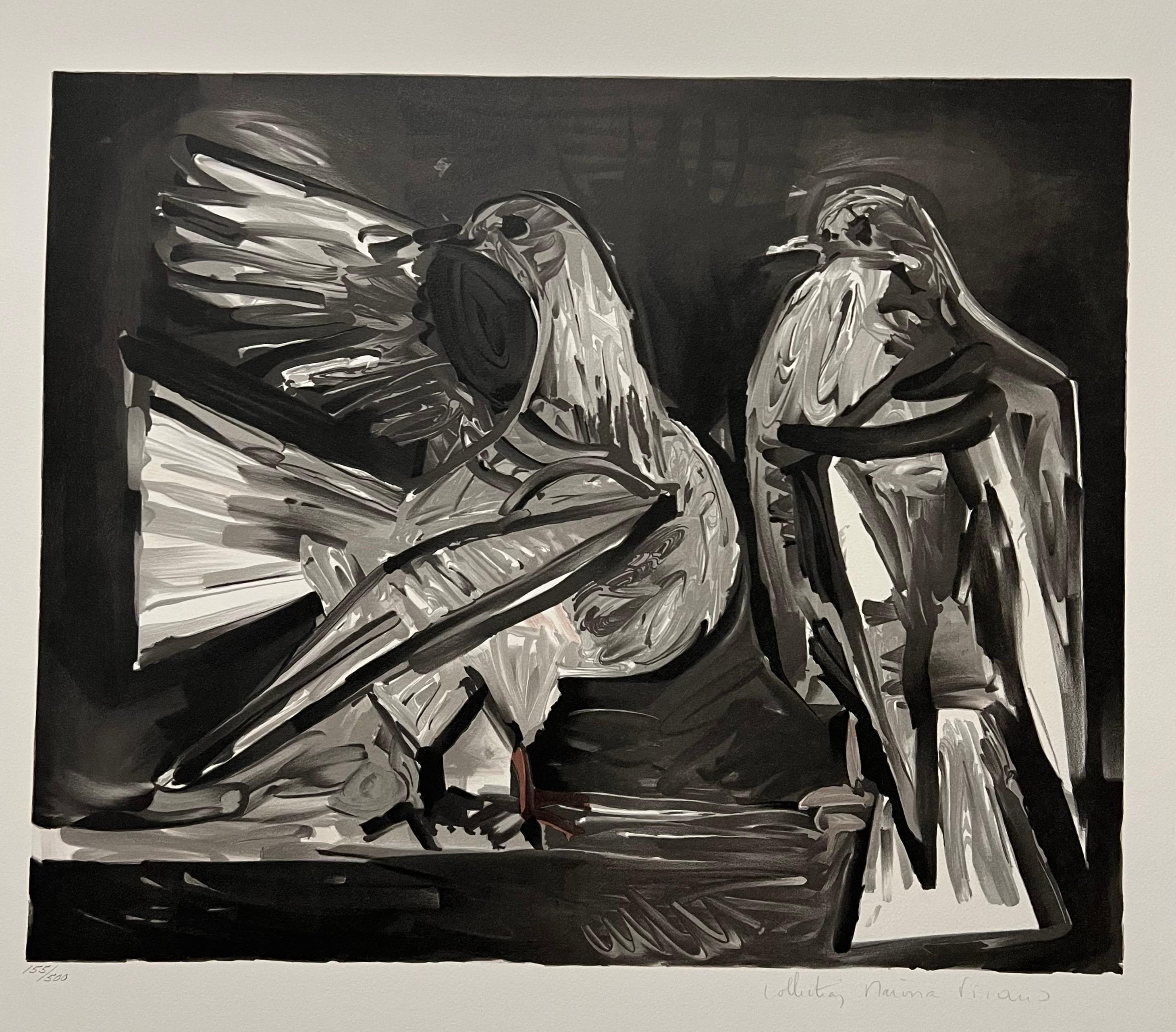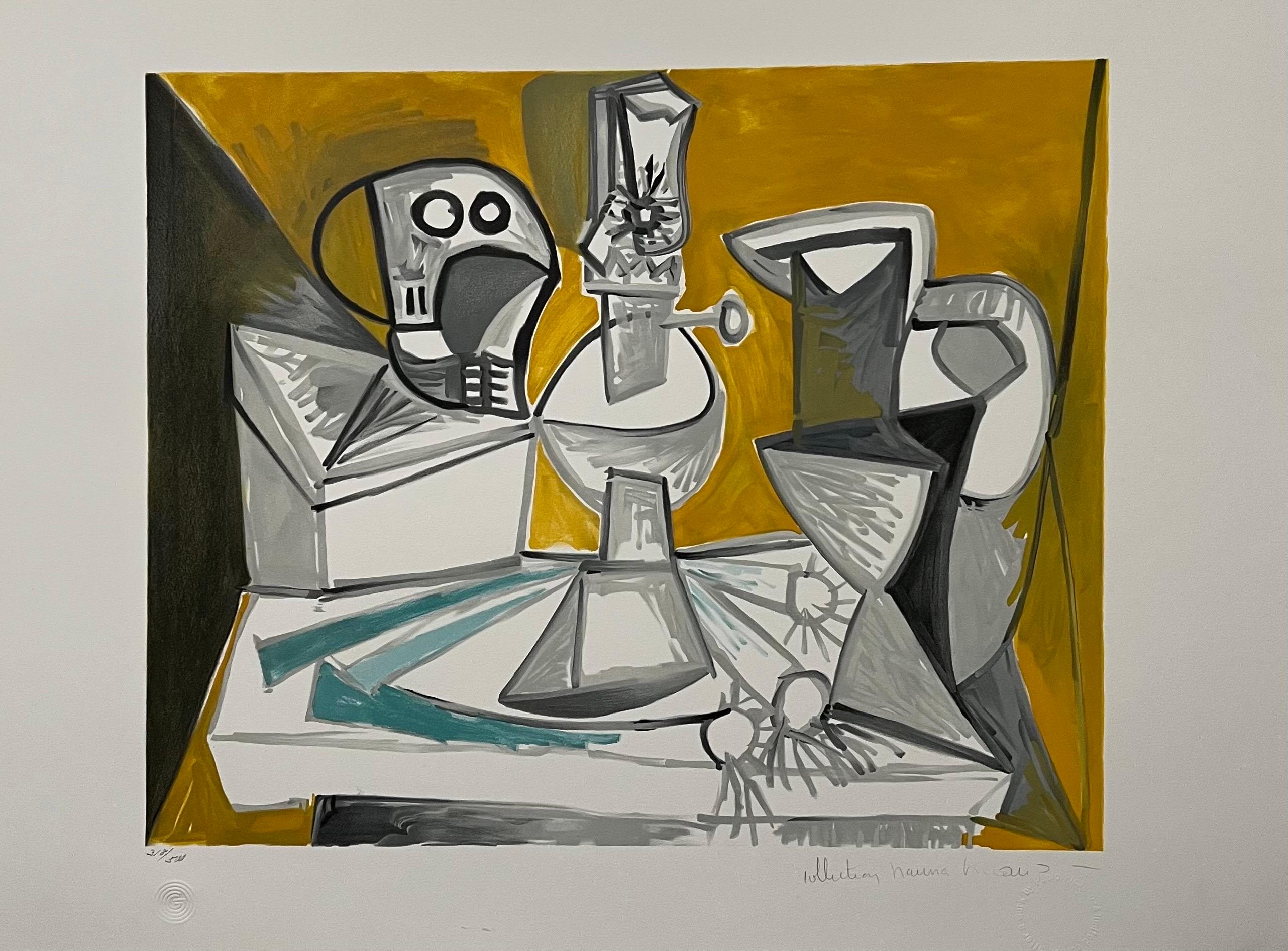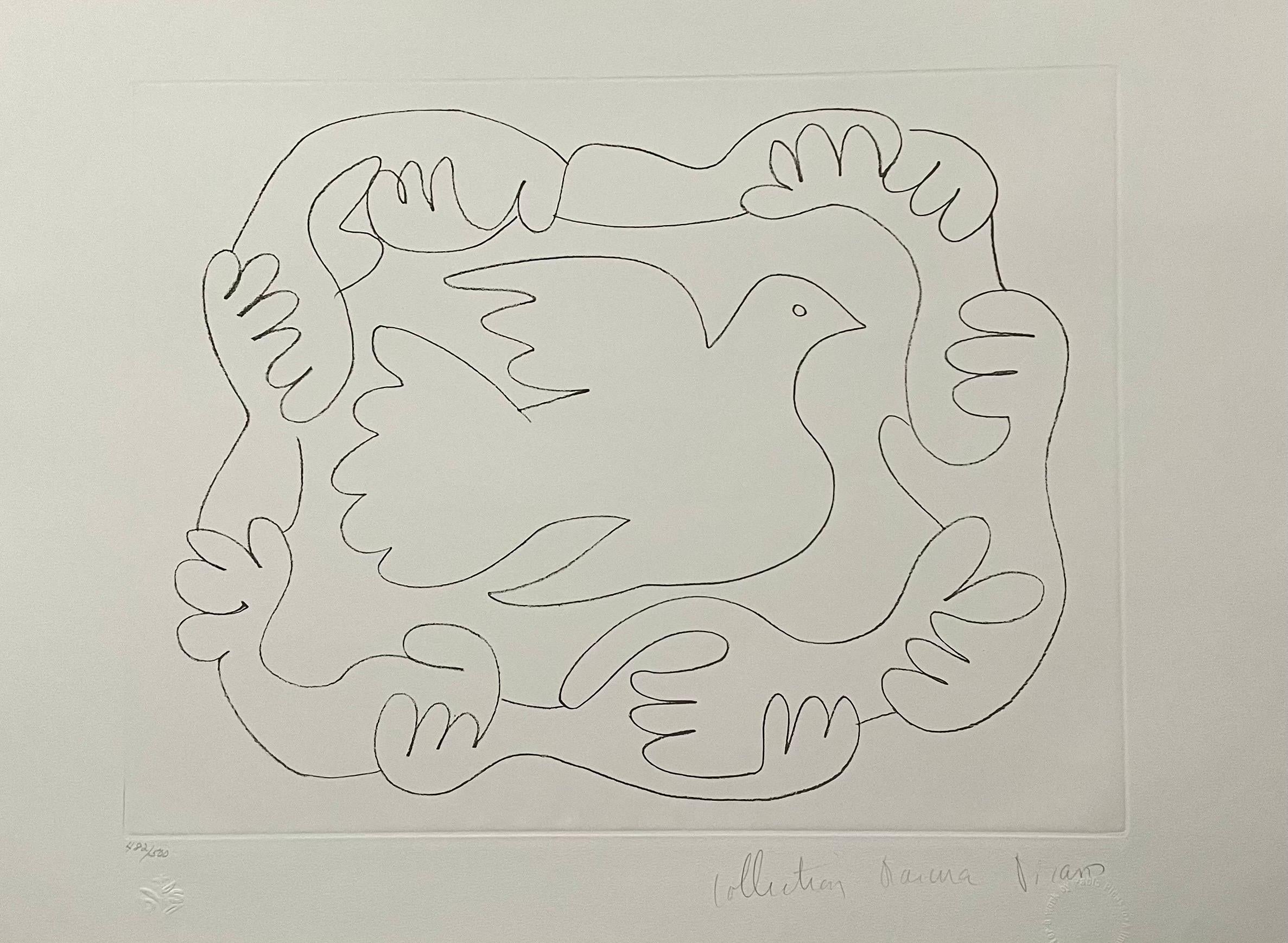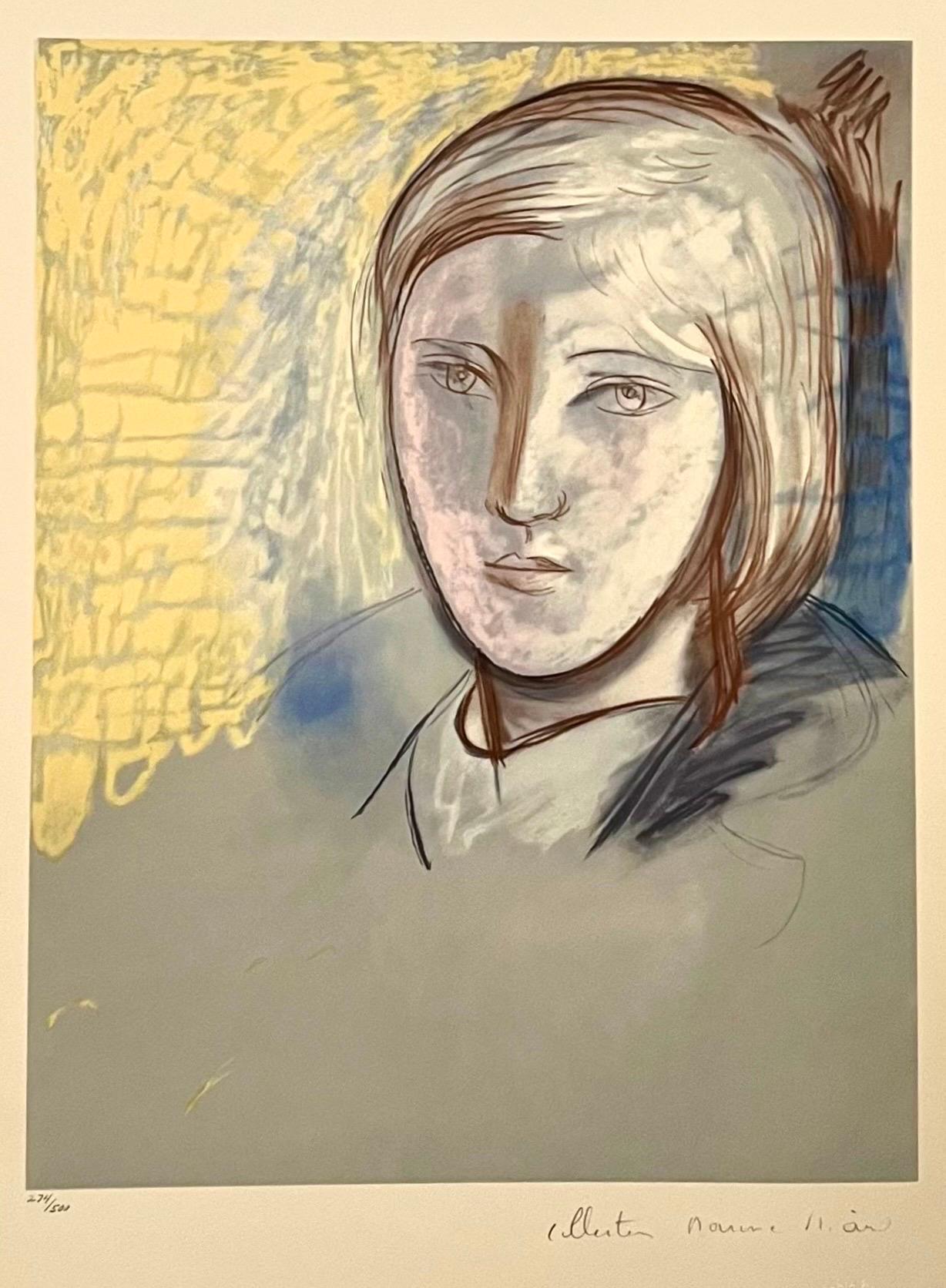Items Similar to Pablo Picasso Estate Hand Signed Cubist Lithograph Abstract Flowers Bouquet
Want more images or videos?
Request additional images or videos from the seller
1 of 15
(after) Pablo PicassoPablo Picasso Estate Hand Signed Cubist Lithograph Abstract Flowers Bouquet
About the Item
Pablo Picasso (after)
"Le Bouquet" Bouquet of flowers, abstract floral arrangement.
limited edition print on Arches paper,
Hand signed by Marina Picasso lower right and numbered 244/500 lower left
From the estate of Pablo Picasso with an embossed blindstamp in the lower right side of the piece.
After Pablo Picasso's death in 1973, his granddaughter Marina authorized the printing of these original lithographs, which have come to be known as the Picasso Estate Collection. The lithographs were meticulously created after the original works (Oil Paintings, Watercolors, Pastels, Charcoal Drawings, etc.) by Master Chromist Marcel Salinas, who worked closely with Picasso in his lifetime. They are printed in an edition of 500 on Arches paper. Embossed with the estate and chromist's stamp seals, along with the legend on the reverse "Approved by the heirs of Pablo Picasso".
Image: 18" x 15". Paper: 29 1/2" x 22".
Pablo Ruiz Picasso (1881 – 1973) was a Spanish painter, sculptor, printmaker, ceramicist, stage designer, poet and playwright who spent most of his adult life in France. Regarded as one of the most influential artists of the 20th century, he is known for co-founding the Cubist movement, the invention of constructed sculpture, the co-invention of collage, and for the wide variety of styles that he helped develop and explore. Among his most famous works are the proto-Cubist Les Demoiselles d'Avignon (1907), and Guernica (1937), a dramatic portrayal of the bombing of Guernica by the German and Italian air forces during the Spanish Civil War.
Picasso demonstrated extraordinary artistic talent in his early years, painting in a naturalistic manner through his childhood and adolescence. During the first decade of the 20th century, his style changed as he experimented with different theories, techniques, and ideas. After 1906, the Fauvist work of the slightly older artist Henri Matisse motivated Picasso to explore more radical styles, beginning a fruitful rivalry between the two artists, who subsequently were often paired by critics as the leaders of modern art.
Picasso's work is often categorized into periods. While the names of many of his later periods are debated, the most commonly accepted periods in his work are the Blue Period (1901–1904), the Rose Period (1904–1906), the African-influenced Period (1907–1909), Analytic Cubism (1909–1912), and Synthetic Cubism (1912–1919), also referred to as the Crystal period. Much of Picasso's work of the late 1910s and early 1920s is in a neoclassical style, and his work in the mid-1920s often has characteristics of Surrealism. His later work often combines elements of his earlier styles.
In 1907, Picasso joined an art gallery that had recently been opened in Paris by Daniel-Henry Kahnweiler. Kahnweiler was a German art historian and art collector who became one of the premier French art dealers of the 20th century. He was among the first champions of Pablo Picasso, Georges Braque and the Cubism that they jointly developed. Kahnweiler promoted burgeoning artists such as André Derain, Kees van Dongen, Fernand Léger, Juan Gris, Maurice de Vlaminck and several others who had come from all over the globe to live and work in Montparnasse at the time.Picasso participated in the School Prints, to bring art to the masses in the 1940's. A magnificent European series, made possible by plastic portable plates, which, in addition to Henry Moore, featured Henri Matisse, Pablo Picasso, Fernand Leger, Raoul Dufy and Georges Braque.
- Creator:(after) Pablo Picasso (1881 - 1973, Spanish)
- Dimensions:Height: 29.5 in (74.93 cm)Width: 22 in (55.88 cm)
- Medium:
- Movement & Style:
- Period:
- Condition:good. never framed. very minor wear. please see photos.
- Gallery Location:Surfside, FL
- Reference Number:1stDibs: LU38212684182
(after) Pablo Picasso
Pablo Picasso (1881 – 1973) was a Spanish painter, sculptor, printmaker, ceramicist, stage designer, poet and playwright who is regarded as one of the most influential artists of the 20th century. He is known for co-founding the Cubist movement, the invention of constructed sculpture, the co-invention of collage, and for the wide variety of styles that he helped develop and explore. Exceptionally prolific throughout the course of his long life, Picasso achieved universal renown and immense fortune for his revolutionary artistic accomplishments, and became one of the best-known figures in 20th-century art. The total number of artworks he produced has been estimated at around 50,000.
About the Seller
4.9
Platinum Seller
These expertly vetted sellers are 1stDibs' most experienced sellers and are rated highest by our customers.
Established in 1995
1stDibs seller since 2014
1,568 sales on 1stDibs
Typical response time: 1 hour
- ShippingRetrieving quote...Ships From: Surfside, FL
- Return PolicyA return for this item may be initiated within 3 days of delivery.
More From This SellerView All
- Georges Braque Bouquet de Fleurs Lithograph Bold Blue Hand Signed Ltd Ed PrintBy Georges BraqueLocated in Surfside, FLGeorges Braque (French, 1882-1963) Bouquet de Fleurs Lithograph in colors, 1957. Published by Maeght, printed by Mourlot, Paris, France Numbered 166/300 and hand signed in pencil. ...Category
20th Century Modern Figurative Prints
MaterialsLithograph
- Pablo Picasso Estate Hand Signed French Expressionist Lithograph "Deux Pigeons"By (after) Pablo PicassoLocated in Surfside, FLPablo Picasso (after) "Deux Pigeons" limited edition print on Arches paper, Hand signed by Marina Picasso lower right and numbered 155/500 lower left Fro...Category
20th Century Modern Abstract Prints
MaterialsLithograph
- Pablo Picasso Estate Hand Signed Lithograph Abstract Cubist CompositionBy (after) Pablo PicassoLocated in Surfside, FLPablo Picasso (after) "Tete De Mort, Lampe, Cruches Et Poireaux" limited edition print on Arches paper, Hand signed by Marina Picasso lower right and numbered 318/500 lower left From the estate of Pablo Picasso with an embossed blindstamp in the lower right side of the piece. After Pablo Picasso's death in 1973, his granddaughter Marina authorized the printing of these original lithographs, which have come to be known as the Picasso Estate...Category
20th Century Modern Abstract Prints
MaterialsLithograph
- Pablo Picasso Estate Hand Signed Lithograph Engraving Fauvist Dove of PeaceBy (after) Pablo PicassoLocated in Surfside, FLPablo Picasso (after) "Etudes des Mains et Colombe" limited edition print on Arches paper, Hand signed by Marina Picasso lower right and numbered 482/500 lower left From the estate of Pablo Picasso with an embossed blindstamp in the lower right side of the piece. After Pablo Picasso's death in 1973, his granddaughter Marina authorized the printing of these original lithographs, which have come to be known as the Picasso Estate...Category
20th Century Modern Abstract Prints
MaterialsLithograph, Engraving
- Pablo Picasso Estate Hand Signed Fauvist Lithograph Woman Portrait Marie ThereseBy (after) Pablo PicassoLocated in Surfside, FLPablo Picasso (after) "Portrait de Marie Therese" limited edition print on Arches paper, Hand signed by Marina Picasso lower right and numbered 274/500 lower left From the estate of Pablo Picasso with an embossed blindstamp in the lower right side of the piece. After Pablo Picasso's death in 1973, his granddaughter Marina authorized the printing of these original lithographs, which have come to be known as the Picasso Estate Collection. The lithographs were meticulously created after the original works (Oil Paintings, Watercolors, Pastels, Charcoal Drawings, etc.) by Master Chromist Marcel Salinas, who worked closely with Picasso in his lifetime. They are printed in an edition of 500 on Arches paper. Embossed with the estate and chromist's stamp seals, along with the legend on the reverse "Approved by the heirs of Pablo Picasso". Image: 19 1/2" x 15". Paper: 28" x 20 3/4". Pablo Ruiz Picasso (1881 – 1973) was a Spanish painter, sculptor, printmaker, ceramicist, stage designer, poet and playwright who spent most of his adult life in France. Regarded as one of the most influential artists of the 20th century, he is known for co-founding the Cubist movement, the invention of constructed sculpture, the co-invention of collage, and for the wide variety of styles that he helped develop and explore. Among his most famous works are the proto-Cubist Les Demoiselles d'Avignon (1907), and Guernica (1937), a dramatic portrayal of the bombing of Guernica by the German and Italian air forces during the Spanish Civil War...Category
20th Century Modern Abstract Prints
MaterialsLithograph
- Henry Moore 1973 Lithograph edition 28/75 Sculpture Figures Reclining NudesBy Henry MooreLocated in Surfside, FLHenry Spencer Moore (1898 – 1986) Moore was born in Castleford, the son of a coal miner. He became well-known through his carved marble and larger-scale abstract cast bronze sculptures, and was instrumental in introducing a particular form of modernism to the United Kingdom later endowing the Henry Moore Foundation, which continues to support education and promotion of the arts. After the Great War, Moore received an ex-serviceman's grant to continue his education and in 1919 he became a student at the Leeds School of Art (now Leeds College of Art), which set up a sculpture studio especially for him. At the college, he met Barbara Hepworth, a fellow student who would also become a well-known British sculptor, and began a friendship and gentle professional rivalry that lasted for many years. In Leeds, Moore also had access to the modernist works in the collection of Sir Michael Sadler, the University Vice-Chancellor, which had a pronounced effect on his development. In 1921, Moore won a scholarship to study at the Royal College of Art in London, along with Hepworth and other Yorkshire contemporaries. While in London, Moore extended his knowledge of primitive art and sculpture, studying the ethnographic collections at the Victoria and Albert Museum and the British Museum. Moore's familiarity with primitivism and the influence of sculptors such as Constantin Brâncuși, Jacob Epstein, Henri Gaudier-Brzeska and Frank Dobson led him to the method of direct carving, in which imperfections in the material and marks left by tools became part of the finished sculpture. After Moore married, the couple moved to a studio in Hampstead at 11a Parkhill Road NW3, joining a small colony of avant-garde artists who were taking root there. Shortly afterward, Hepworth and her second husband Ben Nicholson moved into a studio around the corner from Moore, while Naum Gabo, Roland Penrose, Cecil Stephenson and the art critic Herbert Read also lived in the area (Read referred to the area as "a nest of gentle artists"). This led to a rapid cross-fertilization of ideas that Read would publicise, helping to raise Moore's public profile. The area was also a stopping-off point for many refugee artists, architects and designers from continental Europe en route to America—some of whom would later commission works from Moore. In 1932, after six year's teaching at the Royal College, Moore took up a post as the Head of the Department of Sculpture at the Chelsea School of Art. Artistically, Moore, Hepworth and other members of The Seven and Five Society would develop steadily more abstract work, partly influenced by their frequent trips to Paris and their contact with leading progressive artists, notably Pablo Picasso, Georges Braque, Jean Arp and Alberto Giacometti. Moore flirted with Surrealism, joining Paul Nash's modern art movement "Unit One", in 1933. In 1934, Moore visited Spain; he visited the cave of Altamira (which he described as the "Royal Academy of Cave Painting"), Madrid, Toledo and Pamplona. Moore made his first visit to America when a retrospective exhibition of his work opened at the Museum of Modern Art in New York City.[28] Before the war, Moore had been approached by educator Henry Morris, who was trying to reform education with his concept of the Village College. Morris had engaged Walter Gropius as the architect for his second village college at Impington near Cambridge, and he wanted Moore to design a major public sculpture for the site. In the 1950s, Moore began to receive increasingly significant commissions. He exhibited Reclining Figure: Festival at the Festival of Britain in 1951, and in 1958 produced a large marble reclining figure for the UNESCO building in Paris. With many more public works of art, the scale of Moore's sculptures grew significantly and he started to employ an increasing number of assistants to work with him at Much Hadham, including Anthony Caro and Richard Wentworth. Moore produced at least three significant examples of architectural sculpture during his career. In 1928, despite his own self-described extreme reservations, he accepted his first public commission for West Wind for the London Underground Building at 55 Broadway in London, joining the company of Jacob Epstein and Eric Gill..At an introductory speech in New York City for an exhibition of one of the finest modernist sculptors, Alberto Giacometti, Sartre spoke of The beginning and the end of history...Category
1970s Modern Abstract Prints
MaterialsLithograph
You May Also Like
- Composition sur fond jauneBy Fernand LégerLocated in Palo Alto, CAutting a new spin on one of his favorite subjects, Léger here depicts tree trunks and logs as objects in space rather than related to the ground. The gnarled branches form an abstract still-life composition, twisting and turning in unanticipated directions. The earthy browns, greens, and yellows contrast with the bold black outlines. The logs appear as though arranged on a platter, presented to the viewer for contemplation. An intriguing aspect of this piece is the tiny box...Category
1950s Modern Abstract Prints
MaterialsLithograph
- Trooper IILocated in Kansas City, MORonald King Trooper II Year: 1970 Color Lithograph Size: 27.5x20.5in Edition: 50 Signed, inscribed and numbered by hand COA provided Ref.: 924802-1359 Bor...Category
1970s Modern Figurative Prints
MaterialsLithograph
- COMPOSITION - Lovely design portraying a future Abstract Expressionist.Located in Santa Monica, CAJAMES CHAPIN (1887 – 1975) COMPOSITION c. 1940 Lithograph signed in pencil, Image 11 7/8 x 7 ¾ inches, sheet 13 5/8 x 10 5/8 inches. Just a hint of mat line in the margins and on the verso. Some remnants of old tape prImarily at the left & right sheet edges. Rather scarce print but possibly published by Associated American Artists. WONDERFUL PORTRAYAL OF AN UP AND COMING ARTIST...Category
1940s American Modern Figurative Prints
MaterialsLithograph
- Study for a Bullfight, Triptych 1987By Francis BaconLocated in London, GBOriginal lithograph in colours on Arches watermarked paper, with full margins, framed Central panel from the triptych of the same title Signed by the artist in pencil, lower right on...Category
1980s Modern Abstract Prints
MaterialsLithograph
- Rainbow Signed 1970s silkscreen & lithograph by pioneering female Fluxus artistBy Mary BauermeisterLocated in New York, NYMary Bauermeister Rainbow, 1973 Lithograph and silkscreen on creamy white paper Hand signed, dated and numbered 56/250 by the artist on the front 19 x 25.5 inches Unframed This work is on the permanent collection of various institutions like: Rice University, Samuel Dorksy Museum of Art, Rutgers Zimmerli Museum and Wheaton College Massachusetts. While studying the fringe sciences the 1970s, Bauermeister created Rainbow (1973), a lithograph and silkscreen. She uses a creamy white background as the base. Two intersecting diagonal bands of color transcend across the page, and black cursive lettering dances over the surface serving as a mind map of interweaving ideas. Through the central band, Bauermeister shifts through the color spectrum; she begins with red and finishes with violet. Inspired by music, she uses strokes of color that are rhythmically smeared across the lithograph. The surface lettering, a kind of visual poetry, explores her interest in human emotion and science. The viewer can see Bauermeister’s thoughts as they flow into one another through the use of words such as bliss, love, and healing. Bauermeister also includes a repetition of words such as cancer, sickness, and cure. The word cancer emerges from a cell-like shape. A careful study of the words shows that they may seem dark in nature; however, she juxtaposes these words against the cheerful title and colors. Perhaps the rainbow symbolizes a new hope, an inspiration for an optimistic future. -Courtesy to the Samuel Dorsky Museum of Art About Mary Bauermeister: A multidisciplinary artist known for her intricate and enigmatic assemblages, Mary Bauermeister (1934-2023) continues to defy categorization with layered works in a range of media. A precursory figure of the Fluxus movement—her studio was the meeting point for a number of defining artists of the avant-garde—her work plays an integral role in the discussion of art, both European and American, that emerged from the 1960s. Her reliefs and sculptures, which have incorporated drawing, text, found objects, natural materials and fabric, reference a plethora of concepts: from natural phenomena and astronomy to mathematics and language, as well as her own “spiritual-metaphysical experiences.” Maturing amidst the currents of Minimalism and Pop Art, Bauermeister’s art has resisted labels due to the singular expression of her interests and concerns, among them the simultaneous transience and permanence of the natural world with experimentations in transparency and magnification, multiplication and variation, structure and order, chance and ephemerality, introversion and extroversion. Her three-dimensional receptacles of thoughts, ideas, and notes contain visual, conceptual, and philosophical paradoxes that challenge perceptions and that offer literal and metaphorical windows into which one can glimpse the inner workings of the artist’s mind. - Courtesy of Michael Rosenfeld...Category
1970s Modern Abstract Prints
MaterialsLithograph, Screen, Mixed Media, Pencil, Graphite
- Soft Screw as Balloon, AscendingBy Claes OldenburgLocated in New York, NYA very good impression of this lithograph on Arches Roll paper. Signed and numbered 25/35 in pencil, lower margin. Printed and published by Gemini G.E.L., Los Angeles, with the blind...Category
1970s Modern Abstract Prints
MaterialsLithograph
Recently Viewed
View AllMore Ways To Browse
Flower Bouquet
Italian Floral Print
Vintage Flower Bouquet
Abstract Floral Print
Vintage Plastic Flowers
Vintage Flowers Names
Vintage Floral Vintage Flower Arrangements
Picasso Collage
Picasso Estate
Signed And Numbered Lithograph Pablo Picasso
Picasso Hand Signed Lithographs
Abstract Floral Vintage
Original Pablo Picasso Drawing
Abstract Cubism Cubist
Pablo Picasso Blue
Pablo Picasso Original Hand Signed
Pablo Picasso After Plates
Pablo Picasso Hand Signed Lithograph
